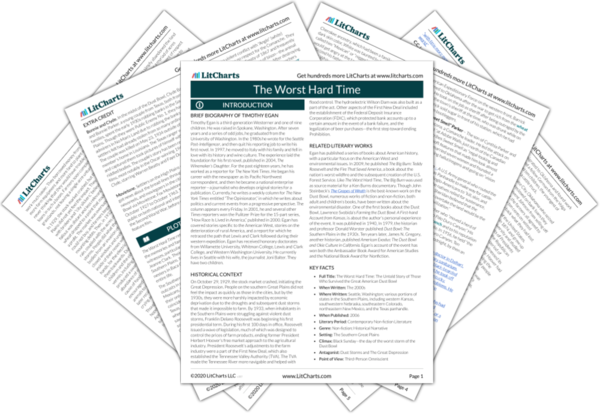Welcome to the LitCharts study guide on Timothy Egan's The Worst Hard Time. Created by the original team behind SparkNotes, LitCharts are the world's best literature guides.
The Worst Hard Time: Introduction
The Worst Hard Time: Plot Summary
The Worst Hard Time: Detailed Summary & Analysis
The Worst Hard Time: Themes
The Worst Hard Time: Quotes
The Worst Hard Time: Characters
The Worst Hard Time: Terms
The Worst Hard Time: Symbols
The Worst Hard Time: Theme Wheel
Brief Biography of Timothy Egan

Historical Context of The Worst Hard Time
Other Books Related to The Worst Hard Time
Key Facts about The Worst Hard Time
- Full Title: The Worst Hard Time: The Untold Story of Those Who Survived the Great American Dust Bowl
- When Written: The 2000s
- Where Written: Seattle, Washington; various portions of states in the Southern Plains, including western Kansas, southwestern Nebraska, southeastern Colorado, northeastern New Mexico, and the Texas panhandle.
- When Published: 2006
- Literary Period: Contemporary Non-fiction Literature
- Genre: Non-fiction; Historical Narrative
- Setting: The Southern Great Plains
- Climax: Black Sunday—the day of the worst storm of the Dust Bowl
- Antagonist: Dust Storms and The Great Depression
- Point of View: Third-Person Omniscient
Extra Credit for The Worst Hard Time
Bonnie and Clyde. In the midst of the Dust Bowl, Clyde Barrow and Bonnie Parker, a young couple from Texas, both from poor families, spent the early 1930s robbing banks in the Southern Plains. Though they were Public Enemy No. 1, they had admirers in No Man’s Land due to robbing the banks that settlers felt had already stolen from so many ordinary citizens. The couple was killed on May 23, 1934 outside of a gang member’s home in Louisiana. The Texas ranger who had hunted and captured them took pictures of himself with their bullet-riddled bodies. The couple’s story has been retold in songs and films, most notably in the Oscar-winning 1967 film, Bonnie and Clyde, starring Warren Beatty and Faye Dunaway.
Movietone. Settlers on the High Plains who went to the movies got news about the bread-lines through Fox Movietone’s newsreels, and moviegoers in the cities heard about the Dust Bowl via Movietone. Fox Movietone’s newsreels ran from October 1927 to October 1963. They informed the American public on both national and international events, particularly the Second World War, before people settled in to watch a feature film.







